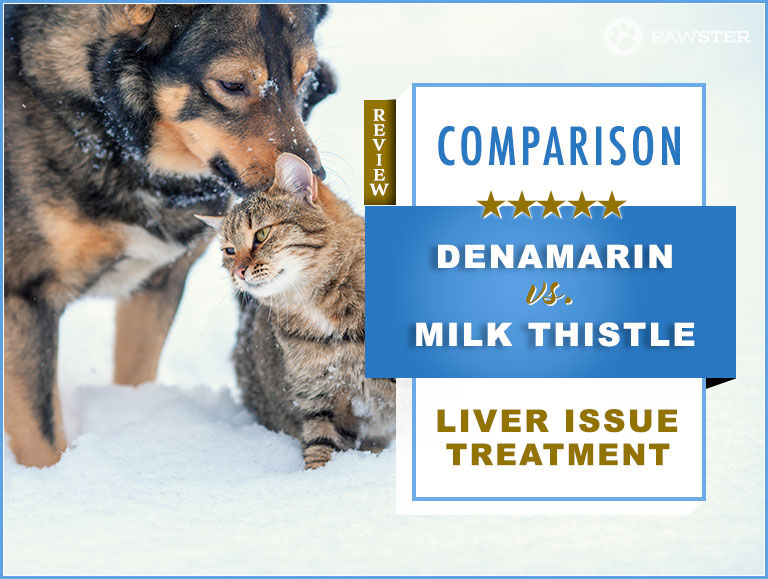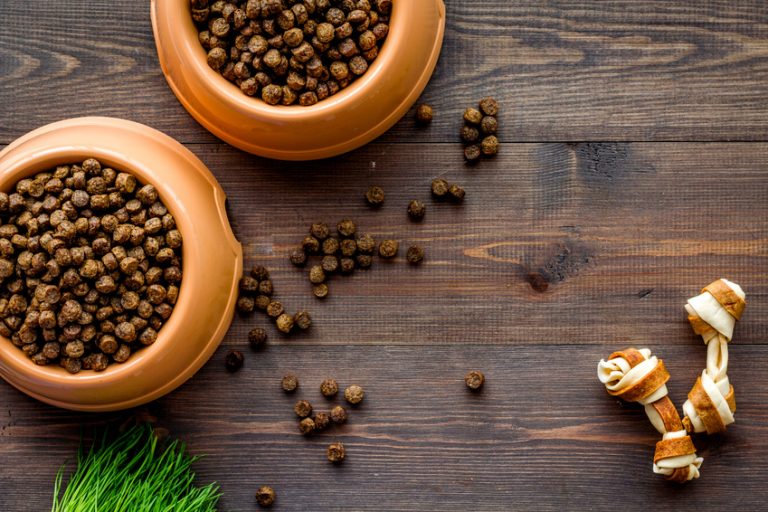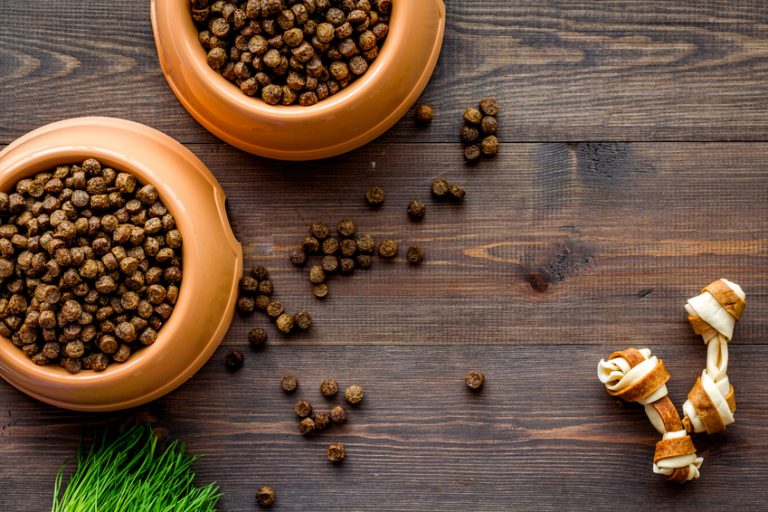Denamarin vs. Milk Thistle : 2024 Comparison and Key Differences

Contents of Article
Your pet’s liver functions have a problem. Maybe during a test, there were some flags, or possibly your pet’s liver disease has progressed to the point that you need a solution. You can do a few things to help ease liver issues with a pet, but the main question is: natural remedy or prescribed solution?
Your vet can help you wade through those decisions and in this article, we’ve got two common solutions for liver issues, one natural and one prescribed. We can help you make the best decision for your furry friend’s health and well-being. Let’s break it all down in our Denamarin versus Milk Thistle review.
Which is Better Denamarin or Milk Thistle for Dogs?
It makes us a little nervous buying natural ingredients because it’s difficult to understand dosing. We also can’t be sure if the company’s product is a quality one. You can find a lot of things on the internet claiming to help your dog, but we think that a substance provided by your veterinarian provides the safest option for supplementation.
Denamarin is our choice because it’s available as a prescription and we know exactly what dose to give and why. Natural products can be fine, but it’s in your pet’s best interest to have a product with proven benefits and some oversight by your veterinarian.
Which is Better Denamarin or Milk Thistle for Cats?
We feel the same way about Denamarin for cats. It comes in an enteric coated tablet to prevent dissolution too early in your cat’s system, and with veterinarian oversight, we feel more comfortable about using the supplement.
In both cases, dogs and cats, directions from your veterinarian are critical. These supplements can be toxic if given at the wrong time or with the wrong medications, so make sure you discuss the entire treatment plan with your vet. Some vets may recommend a specific milk thistle product, and you should follow their advice. Barring that, we prefer the official supplement Denamarin.
Our Review of Denamarin and Milk Thistle
This is an interesting comparison because it’s a question of the natural ingredient versus an extracted “active” ingredient. There isn’t a difference between the two. It’s all about the source.
The main ingredient is a compound called Silymarin, a combination of three different chemicals. It’s an antioxidant that helps bind toxins and support liver function. In Denamarin, s-adenosylmethionine or SAMe plus silybin (part of the silymarin compound) work together for the same effect.
Key Differences Between Denamarin and Milk Thistle
Let’s look at how the two differ.
Method of Delivery
Denamarin is offered in a chewable tablet for dogs, making it easy to administer. Your vet can work with you to determine the amount and frequency. You might not use the supplement long term for preventative situations, or it may become part of your pet’s regimen for the management of progressed liver disease and other issues.
Milk thistle varies across brands and can be confusing to dose correctly. Milk Thistle available through your vet’s office can help alleviate some of the confusion because you have direction from your vet. It sometimes comes in a chewable tablet, but more often it’s a liquid supplement that you can add to your pet’s food or water.
Age
Milk Thistle safety can vary wildly between manufacturers, so it’s important that you consult your vet and only get your milk thistle products from reputable dealers. The age at which milk thistle is appropriate will depend on the manufacturer.
Denamarin is based on weight and usually given to full grown dogs based on that information. Your vet will decide when the supplement is appropriate. It’s generally for dogs with signs of liver issues or for senior dogs with progressed liver disorders.
Denamarin and Milk Thistle Active Ingredients Comparison
They both use one particular ingredient, but Denamarin adds a compound that makes it more bioavailable.
Milk Thistle: Silybin
Studies suggest that this compound has strong anti-oxidant abilities in addition to helping to reduce inflammations. Pets whose liver functions are compromised may have trouble eliminating toxins from the body. Silybin encourages the liver to build new cells for processing toxins and may help reduce overall inflammation in the body due to poor elimination.
Denamarin: Silybin + SAMe
SAMe encourages the production of something called glutathione, a substance that helps form healthy liver cells and prevent liver cells from early cell death. It also may help regenerate damaged tissues within the liver so that the organ can better handle the toxic load of the body.
Silybin further encourages oxidative balance, meaning free roaming toxins are swept up and prevented from stressing the cells in the liver. The formula makes the entire system more available to your pet’s body for better results than just Silybin alone.
Which Treatment is the Best Priced?
The price of milk thistle varies widely between manufacturers, but overall, milk thistle is an affordable, holistic option. Be sure you get recommendations from your veterinarian, and you know the reputation of the manufacturer.
Denamarin requires a prescription, so in addition to the cost, you’ll have to factor in the cost of your vet visit. However, because dosing is standard, you know exactly what you’re getting for the price. Plus, with the addition of SAMe, you also get a more well-rounded supplement. Overall, Denamarin a better option.
Which Do We Recommend?
We recommend Denamarin. We can’t stress enough how difficult it is for us to know everything about general milk thistle supplements. If your vet has one that he or she trusts, we fully support adding it to your pet’s supplement regimen.
However, if you’re just now beginning to treat liver issues, more than likely, your vet will want to go with a supplement option that’s standardized and available through a prescription. We recommend this route because it’s more transparent and (once again) easier to find out exactly how much of the compound is in each tablet and how much you should be giving your pet at each dose.
We favor this standardized approach because it’s hard to keep up with every facet of your pet’s diet, supplements, and medications. Knowing what reacts with what is key to keeping your pet’s body in peak condition. When you and your vet know precisely what’s going on, you can make better decisions. Chose Denamarin if your vet doesn’t have a trusted milk thistle supplement.
7 Treatment Application Tips
Giving pets supplements can be tricky. Here are a few things to keep in mind.
- If you aren’t sure that your pet needs a liver supplement in the first place, there are a few signs you should discuss with your vet. It’s crucial to catch liver issues early because that gives you the best chance of treating and possibly reversing the damage that’s already been done. If your dog has been on long-term medications (including heartworm or flea preventions), steroids, or even poorly made, processed dog foods, the liver could be at risk. Keep an eye out for:
- sudden digestive disorders (changing food/treats doesn’t help)
- pinkish eyes or eyes with unusual discharge
- fatigue not associated with advanced age and lack of interest in favorite activities
- dark urine
- dull eyes or issues with corneas and eyesight in general
- dry, infected, or overall brittle nails
- Don’t give your pet anything new to eat or drink at least a week before and after starting the supplement. Adding new foods to your pet’s diet can make it difficult to know if your pet is having an adverse reaction to the supplement or the new food. Removing doubt helps keep your pet safe and you well informed.
- If your pet doesn’t like the chewable tablet, we like the sandwich method for administering doses. Use two of your pet’s favorite treats. Give them one treat, then the supplement, then the second treat. Sometimes pets are so focused on their favorite treat they won’t notice the dose in the middle. Don’t overfeed, however, because Denamarin needs to be given on an empty stomach for best absorption.
- Tablets can be disguised in a bit of food to make them more palatable. Again, be sure not to use too much food because the supplement works best on an empty stomach. Disguise the tablet in a bit of cheese or lunch meat to help. Sometimes, letting your pet smell the treat before you put the pill inside can help with extremely picky pets.
- Some sources on the internet suggest using milk thistle products to help repair damage from other types of medications (including flea and tick treatments). There is little evidence to support this assertion. Using milk thistle on healthy pets may cause adverse side effects and can interact poorly with other treatments your pet might be taking. Talk to your veterinarian if you’re worried about the long-term effects of any of your pet’s current medications for better ways to prevent liver damage.
- If you choose an alternative to Denamarin, make sure you aren’t getting a milk thistle supplement formulated for humans. Pets have different needs than humans and using a supplement created for human consumption can lead to improper dosing. Milk thistle created just for pets has more accurate dosing directions and warnings. Not everything that’s “human-grade” is best for pets.
- If you choose a basic milk thistle product, be sure to look for the percent of Silymarin (the compound containing Silybin) found in each dose. It shouldn’t be anything less than 70 to 80 percent, or you risk getting an inferior product. This concentration is the most helpful for dosing and gives you a better idea about how much your pet is receiving.
Final Thoughts
If you catch liver damage early, it gives your pet the best chance. There’s currently no cure for advanced liver disease, so treating early symptoms can help alleviate further damage and give your pet the best chance at a quality life. Supplements can certainly improve your pet’s condition provided the damage to the liver isn’t so far gone that it can’t regenerate.
Pay careful attention to any supplement that you might introduce to your dog because not all supplements are created equal. That’s why we like prescription supplements that you can get from your vet. The dosing is consistent, the supplement amount is clear, and we get the added assurance that our vet is in the loop for our pet’s entire care.
The signs of liver disease are so varied that it’s essential to be vigilant and pay attention to what your pet’s body may be telling you early on. Once you have confirmation, taking action with Denamarin can help prevent more issues down the road.
Is your pet showing signs of liver disease already? Is it more advanced? Let us know how you’re approaching your pet’s treatment in the comments below.







I am currently using Denamarin for my 9 year old cat with liver disease. We don’t know if it is cancer because we never had a biopsy since I did not want to put her through that. Her liver enzymes are high and have increased over the past year. If I administer Milk Thistle along with the Denamarin, will this cause problems. I understand Milk Thistle helps get rid of toxins in the liver. Any advice?